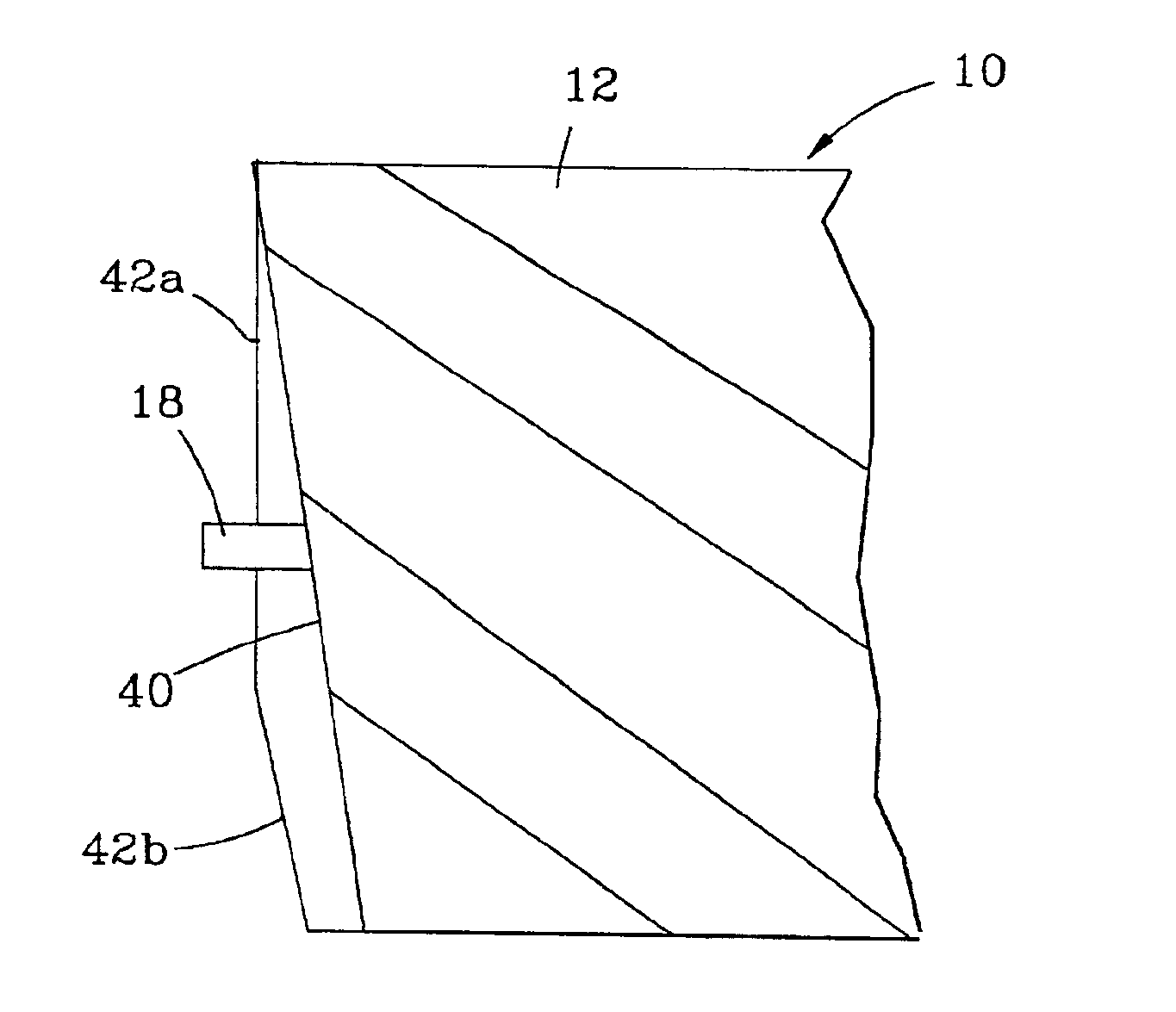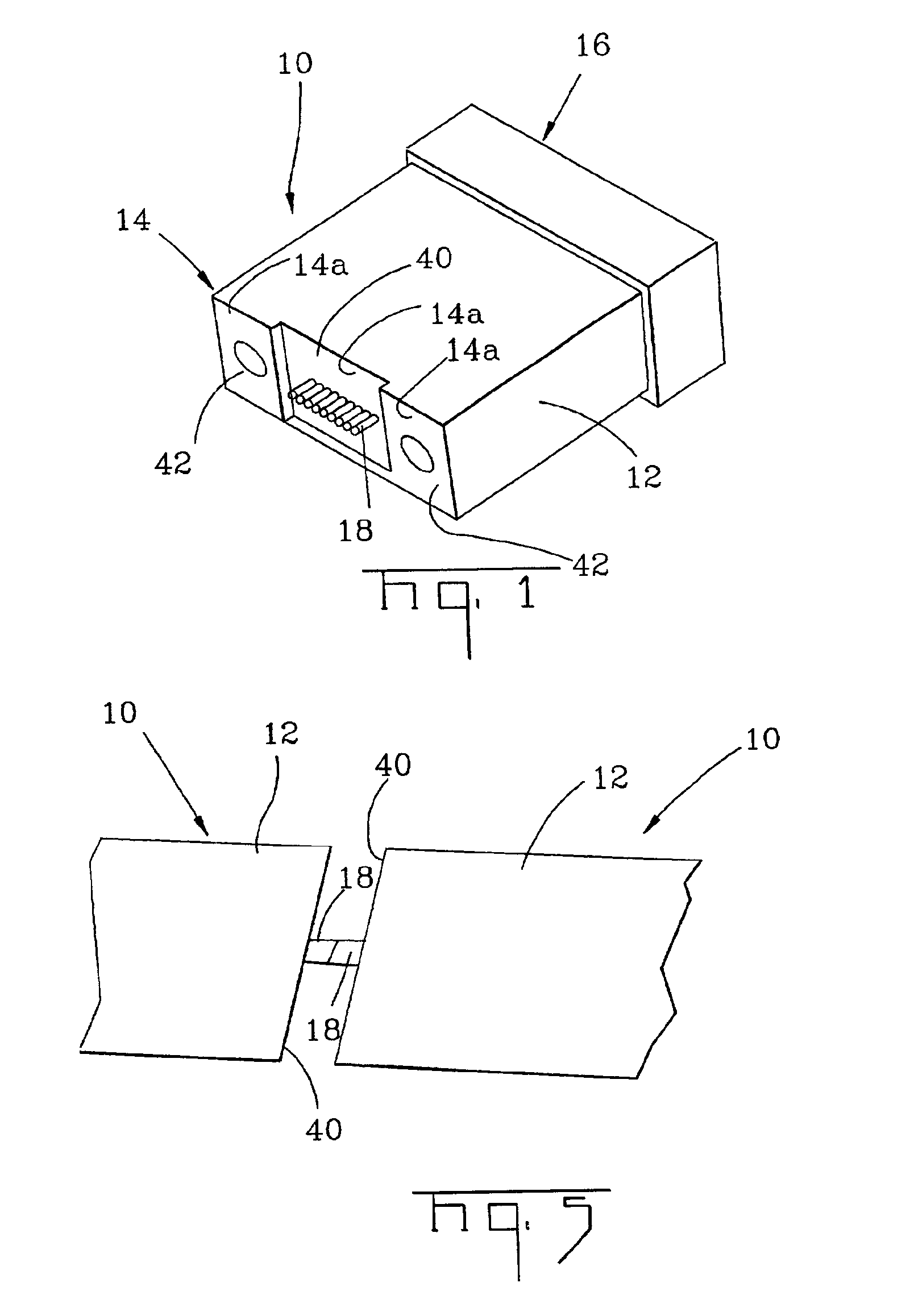[0011]A ferrule assembly having highly protruding optical fibers and a corresponding method of efficiently, precisely and repeatedly fabricating ferrule assemblies having highly protruding optical fibers are provided according to the present invention. According to one aspect of the present invention, a ferrule assembly is provided that includes a plurality of optical fibers extending at least about 3.5 μm, taking account of customary manufacturing tolerances, beyond all portions of the front face. The end portions of the optical fibers of the ferrule assembly may also be substantially coplanar in that the end portions of the optical fibers differ in position from one another by no more than about 100 nm according to one embodiment. Thus, a pair of ferrule assemblies of the present invention may be mated such that direct physical contact is maintained between the end portions of the optical fibers even while the ferrule deforms and the optical fibers withdraw as a result of environmental conditions, loading or the like.
[0013]The end portions of the optical fibers may also be polished with a flocked material. For example, the end portions of the optical fibers may be polished with a flocked material, typically a fine flocked material, after the end portions of the optical fibers have been lapped, such as to round the edges of the optical fibers. In addition, the end portions of the optical fibers may be polished with a coarse flocked material prior to lapping the end portions of the optical fibers to reduce the protrusion of the optical fibers and to remove at least some or all of the
epoxy from the front face of the ferrule. Generally, the coarse flocked material has larger
abrasive particles than the flocked material with which the end portions of the optical fibers are polished following lapping of the end portions of the optical fibers. According to this aspect of the present invention, the method efficiently fabricates a ferrule assembly having protruding optical fibers since the end portions of the optical fibers generally remain extended beyond the front face of the ferrule during the entire process, thereby obviating the need to
grind or polish the end portions of the optical fibers flush with the front face of the ferrule prior to preferentially
etching the front face of the ferrule relative to the end portions of the optical fibers as practiced by conventional techniques.
[0015]Regardless of the amount of protrusion, the end portions of the optical fibers of the ferrule assembly according to one aspect of the present invention are substantially co-planar in that the end portions differ in position from one another by no more than 100 nm. Additionally, the end portion of each
optical fiber preferably differs in position from the end portions of the immediately adjacent optical fibers by no more than 50 nm. By utilizing fine
abrasive particles, the core dip is also reduced, such as to less than 10 nm, as well as the possibility of core cracking for multimode optical fibers. By protruding at least about 3.5 μm beyond the front face of the respective ferrule and, in some embodiments, by exhibiting improved co-planarity and reduced core dip, a pair of ferrule assemblies may be mated so as to maintain the end portions of corresponding pairs of optical fibers in direct physical contact, even as the environmental conditions, loading and other factors vary.
[0016]According to one aspect of the present invention, the front face of the ferrule may at least initially include at least one polishing feature to further improve the efficiency of the fabrication process and quality and
repeatability of the resulting ferrule assemblies. In addition to the polishing feature, the front face of the ferrule may also include a first portion through which the bores at least partially open. The polishing feature is offset with respect to a first portion. For example, the polishing feature may be a recessed portion having a
reference surface, such as a planar or a curved
reference surface, that extends in a rearward direction from the first portion of the front face. Alternatively, the polishing feature may be at least one pedestal having a planar surface that extends outwardly from the first portion of the front face of the ferrule, such as by a distance approximately equal to the desired protrusion of the optical fibers. In this embodiment, the ferrule can include first and second pedestals positioned on opposite sides of the first portion of the front face and extending outwardly therebeyond. For example, the plurality of bores may open through the front face along a
reference line extending between opposite sides of the ferrule body. As such, the first and second pedestals of this embodiment may be positioned
proximate the opposite sides of the ferrule body along the
reference line.
[0021]While reducing the protrusion of at least one
optical fiber according to one embodiment, the spacing between the line of intersection and the at least one optical fiber may be monitored and the protrusion of the at least one optical fiber may continue to be reduced at least until the spacing between the line of intersection and the at least one optical fiber is no more than a predefined spacing. Since the spacing between the line of intersection and the optical fibers provides a measure of the amount of protrusion of the at least one optical fiber, the predefined spacing may be selected to correspond to a desired protrusion of the at least one optical fiber. By halting any further reduction in the protrusion of the at least one optical fiber once the predefined spacing is detected, the resulting ferrule will have an optical fiber with the desired protrusion. Moreover, by monitoring the spacing between the line of intersection and the at least one optical fiber, such as with a vision
system, the method of this aspect of the present invention can reliably fabricate ferrules having optical fibers with a desired protrusion without requiring a relatively expensive interferometer to measure the protrusion of the optical fibers as is required by most conventional techniques. Additionally, the angle between the line of intersection and a
reference line extending through the plurality of optical fibers may also be monitored since this angle corresponds to the angle at which the end portions of the optical fibers are being polished.
[0022]According to the present invention, ferrule assemblies are therefore provided having highly protruding optical fibers, such as optical fibers that protrude by about 3.5 μm to about 5 μm or more beyond the front face of the ferrule. In addition, ferrule assemblies having protruding optical fibers that are substantially co-planar, such as optical fibers having end portions that vary by no more than about 100 nm, are also provided. In
mating a pair of multifiber connectors, direct physical contact between the end portions of corresponding pairs of optical fibers can be therefore be established and maintained. In addition, by polishing the end portions of the optical fibers to establish the desired protrusion without ever having to remove substantial portions of the front face of the ferrule one can increase the fabrication efficiency, particularly in instances in which the ferrule includes at least one polishing feature to define the desired protrusion distance.
 Login to View More
Login to View More  Login to View More
Login to View More 


